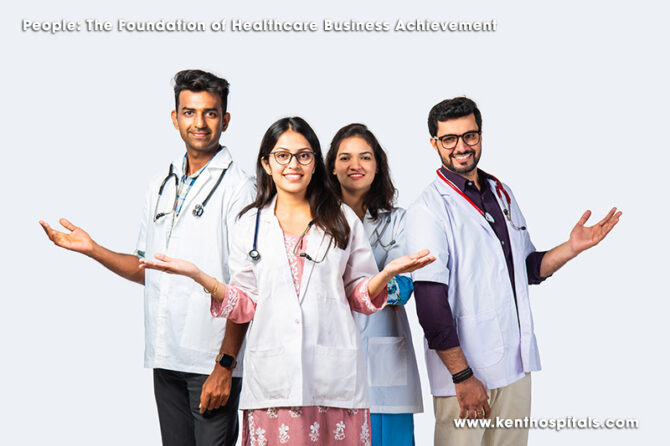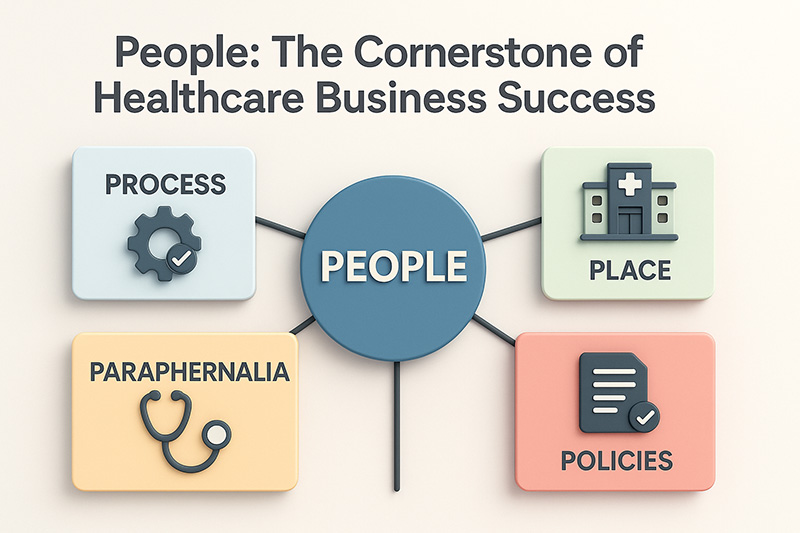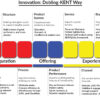
Healthcare organizations generally strive to manage a delicate balancing act: sustain financial performance while assuring quality care, ethical responsibility, and trust by patients. Of the 5 Ps of Healthcare Success—People, Process, Paraphernalia, Place, and Policies—People are the final driving force that energizes everything else. Even the finest technology, perfectly structured processes, or new facilities will amount to little in results without committed people.
Why People Matter More Than Infrastructure
In contrast to manufacturing or retailing, services in hospitals are distinctly human. The customer who enters a hospital does not evaluate at all, or at least, the design, equipment, or technology. What is more important, much more, is that which is human—the surgeon’s competence, nurse’s care, counsellor’s clarity, and administrator’s efficiency.
Globally, Johns Hopkins Hospital is known not only for innovation but also for its culture of teamwork. Through its “Culture of Safety” program, it gives every employee, from janitors to senior consultants, permission to voice concerns about safety without fear of reprisal. The culture has decreased error and boosted trust.
In India, Mumbai’s Tata Memorial Centre has become a beacon of cancer care, more because of its dedicated oncologists, nurses, and social workers who venture beyond work in the clinics to take care of families economically and in terms of their emotions. That indicates that human capital outweighs physical capital in effective care.
As Peter Drucker, the management thinker, asserts:
“A 21st-century institution’s best asset will be its knowledge workers and their productivity.”
People Build Trust, and Trust Builds Business
Healthcare brands rise and fall in direct ratio to trust. Reputation is fragile; one negative encounter with a caregiver will erase a decade of institutional reputation. But empowered staff will transform patients into permanent brand advocates.
Take, for example, Aravind Eye Care System in Tamil Nadu. The greatest numbers of cataract operations in the world, by some measures, are done by its surgeons, while what actually lies behind its success is its doctors’ warmth and judicious education of nurses and support staff. The organization’s philosophy, rooted in Swami Vivekananda’s vision of “service as worship,” shows how people’s principles can be converted into better experiences of patients.
Globally, Cleveland Clinic reframed its entire staff as “caregivers”—doc, janitor, or administrator. The new name inspired ownership, getting them all in sync with its mission to heal. The commercial consequence? Better patient satisfaction surveys and repeat confidence.
People as Innovators and Problem-Solvers
Health concerns—from prices to disparities in access—won’t be fixed by machines. Humans creatively work under constraints.
Sri Sathya Sai Institute of Higher Medical Sciences, Bengaluru & Puttaparthi, provides free tertiary care in cardiology and neurosurgery, made possible entirely by motivated healthcare professionals who view service as a calling.
In reaction to the pandemic of COVID-19, frontline workers in India developed “jugaad” solutions, such as converting small oxygen delivery systems into short-term ventilatory care, salvaging innumerable lives.
Around the world, Sweden’s Karolinska Institute combines science and bedside care, so that scientists and doctors can collaborate mutually to develop solutions. Most breakthroughs in oncology and neuroscience come out of this person-centric approach.
As Dr. A.P.J. Abdul Kalam reminded:
“Leadership in the final analysis is about developing people’s spirits.” Healthcare organizational leaders should then develop innovation at every echelon.

People Development as a Strategic Imperative
Recruitment is not enough. The real discriminator in business is in terms of continued instruction, leader development, and welfare of personnel.
- Continuous Learning
Medicine is continuously evolving. NIMHANS, Bengaluru, believes in continuation of skill upgradation by means of workshops as well as by means of digital platforms of learning so that mental professionals remain world-centric.
2. Leadership Pipelines
Around the world, Singapore’s health sector invests in leadership training among physician and nurse practitioners by blending clinical expertise and management savvy. Dual competency helps decision-making in complex hospital settings.
3. Employee Well-Being
Doctor and nurse burnout is a silent epidemic. Hospitals like India-based Fortis Healthcare introduced wellness programs made up of counselling, peer mentoring, and work-life strategies. Investment in staff wellness reduces attrition and improves patient care.
4. People as Ethical Anchors
Processes and technology can be duplicated, ethics and culture, though, can’t. The people are the conscience of a healthcare enterprise.
Christian Medical College (CMC), Vellore, renowned for having a patient-centered mission whereby doctors, nurses, and social workers ensure caring treatment and specifically to rural and underserved populations. Their focus on educating allied health professionals has yielded generations of highly trained caregivers.
On the other hand, international scandals like Britain’s Mid Staffordshire NHS Trust, whereby negligence and understaffing led to harm to individuals, also act as a reminder that cost-cutting measures by excluding the human element can erase reputation and trust.
Mahatma Gandhi’s timeless words are fitting:
“A customer is not an interruption in our work; he is the purpose of it.”
Business Lessons for Leaders
- Treat Staff as Partners, Not Costs
Pay and rewards must match responsibility. Staff loyalty lowers turnover and protects brand equity.
2. Create Inclusive Cultures
Encourage loops of back-and-forth feedback so that everyone, from junior nurses to senior advisers,
3. Spend in Ethics and Empathy
Train caregivers in soft skills as much as in clinical ability. Moral practice enhances short- and long-term profitability.
Fostering Inter-Departmental Collaboration
Interdisciplinarity facilitates effective teamwork, maximizing efficiency and minimizing duplicate effort.
Measure Human Impact
Don’t look at financials alone. Track employee engagement, training hours, and staff retention as indications of organizational vitality.
Final thoughts
In 5 Ps of Successful Healthcare model, People remains the single most deciding pillar. Processes, paraphernalia, place, and policies can scale up outputs only when correct people, with correct capability and principles, breathe life into them. From Aravind and Christian Medical College of India to global benchmarks like Mayo and Cleveland Clinic, there is that one message: people alone are the differentiator in successful healthcare business.
The best infrastructure can awe, and new technology can inspire, but only humans repair, reassure, and build trust. For sustainable development, as desired by life sciences companies, there is one unequivocal strategic imperative: investing in people, first.
Dr. Prahlada N.B
MBBS (JJMMC), MS (PGIMER, Chandigarh).
MBA in Healthcare & Hospital Management (BITS, Pilani),
Postgraduate Certificate in Technology Leadership and Innovation (MIT, USA)
Executive Programme in Strategic Management (IIM, Lucknow)
Senior Management Programme in Healthcare Management (IIM, Kozhikode)
Advanced Certificate in AI for Digital Health and Imaging Program (IISc, Bengaluru).
Senior Professor and former Head,
Department of ENT-Head & Neck Surgery, Skull Base Surgery, Cochlear Implant Surgery.
Basaveshwara Medical College & Hospital, Chitradurga, Karnataka, India.
My Vision: I don’t want to be a genius. I want to be a person with a bundle of experience.
My Mission: Help others achieve their life’s objectives in my presence or absence!
My Values: Creating value for others.
Leave a reply
















*Dear Dr. Prahlada N.B Sir,*
Your insightful article on "People: The Foundation of Healthcare Business Achievement" resonated deeply with me. As healers of disease, we indeed have a sacred responsibility to prioritize the well-being of our patients and treat every individual with respect and dignity.
*Treating All with Respect: A Divine Mandate*
Just as Dr. Rajkumar affectionately addressed his fans as "Abhimani devaragalu" (godly fans), we should view our patients and colleagues as divine beings, deserving of our compassion, care, and kindness. By doing so, we not only uplift others but also elevate ourselves in the process.
*A Symphony of Equality*
In a hospital setup, every individual, regardless of their role or position, contributes to the grand symphony of patient care. Just as a beautiful orchestra requires harmony among its musicians, we too must work together in perfect synchrony, valuing each other's expertise and efforts.
*The Ripple Effect of Kindness*
When we treat others with respect and kindness, it creates a ripple effect, inspiring others to do the same. This fosters a culture of empathy, compassion, and excellence, ultimately benefiting our patients and the community we serve.
*A Beacon of Hope*
As healthcare professionals, we are beacons of hope for those seeking healing and comfort. By embracing the motto "do good to patients" and treating all with respect, we can make a profound difference in the lives of others, leaving a lasting legacy of love, care, and kindness.
*In Gratitude and Appreciation*
Thank you, Sir, for sharing your wisdom and insights with us. May your words inspire us to strive for excellence in patient care, fostering a culture of compassion, empathy, and respect that transcends boundaries and touches hearts.
With deepest respect and admiration,
🙏
Reply